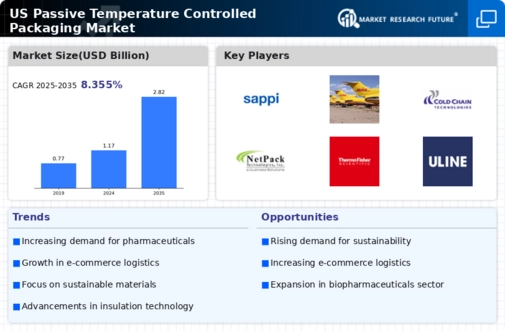Rising Demand for Biopharmaceuticals
The increasing demand for biopharmaceuticals in the US is a key driver for the passive temperature-controlled-packaging market. As the biopharmaceutical sector expands, the need for effective temperature management during transportation and storage becomes critical. Biopharmaceuticals often require strict temperature controls to maintain efficacy, which drives the demand for passive packaging solutions. The market for biopharmaceuticals is projected to reach approximately $500 billion by 2025, indicating a substantial growth trajectory. This growth necessitates reliable packaging that can maintain specific temperature ranges without active energy sources, thereby enhancing the appeal of passive temperature-controlled-packaging solutions. Consequently, the The passive temperature-controlled-packaging market is likely to benefit from this trend., as companies seek to ensure product integrity and compliance with stringent regulations.
Consumer Awareness of Product Quality
Increasing consumer awareness regarding product quality and safety is driving the passive temperature-controlled-packaging market. As consumers become more informed about the importance of proper temperature management for perishable goods, they are demanding higher standards from manufacturers and retailers. This heightened awareness is particularly evident in the food and pharmaceutical sectors, where temperature fluctuations can compromise product integrity. The passive temperature-controlled-packaging market is well-positioned to address these concerns, as it provides solutions that ensure products remain within specified temperature ranges during transit. With a growing emphasis on quality assurance, companies are likely to invest in passive packaging solutions to enhance their brand reputation and meet consumer expectations, thereby fostering growth in the market.
E-commerce Growth and Cold Chain Logistics
The rapid expansion of e-commerce in the US is significantly influencing the passive temperature-controlled-packaging market. As online shopping continues to grow, particularly in sectors like food and pharmaceuticals, the demand for efficient cold chain logistics is paramount. The e-commerce food delivery market alone is expected to surpass $100 billion by 2025, necessitating effective temperature-controlled solutions to ensure product quality during transit. Passive temperature-controlled packaging offers a cost-effective and reliable method to maintain temperature stability without the need for active refrigeration. This trend indicates a shift towards more sustainable and efficient packaging solutions, which could further propel the growth of the passive temperature-controlled-packaging market as businesses adapt to meet consumer expectations for quality and safety.
Regulatory Pressures for Temperature Control
Regulatory pressures surrounding temperature control in the transportation of sensitive goods are a significant driver for the passive temperature-controlled-packaging market. In the US, regulatory bodies impose strict guidelines on the storage and transportation of pharmaceuticals and food products to ensure consumer safety. Compliance with these regulations often necessitates the use of effective temperature-controlled packaging solutions. As regulations become more stringent, companies are increasingly turning to passive temperature-controlled packaging to meet these requirements without incurring high operational costs associated with active systems. This trend suggests that the passive temperature-controlled-packaging market will continue to grow as businesses seek to align with regulatory standards while maintaining product integrity.
Technological Advancements in Packaging Materials
Technological advancements in packaging materials are playing a crucial role in shaping the passive temperature-controlled-packaging market. Innovations in insulation materials and phase change materials (PCMs) have led to the development of more efficient passive packaging solutions. These advancements allow for better temperature retention and longer shipping durations without compromising product quality. For instance, the introduction of advanced insulation materials can enhance the thermal performance of passive packaging, making it more appealing to businesses in the food and pharmaceutical industries. As companies seek to optimize their supply chains and reduce costs, the adoption of these innovative materials is likely to increase, thereby driving growth in the passive temperature-controlled-packaging market.




















Leave a Comment